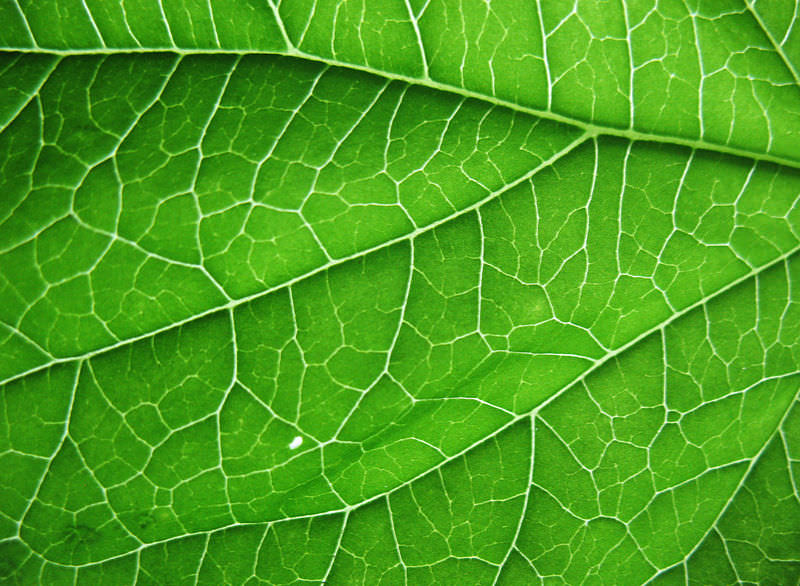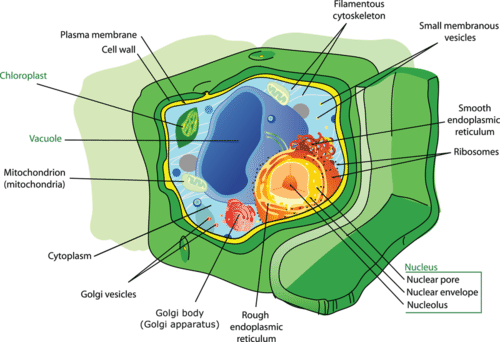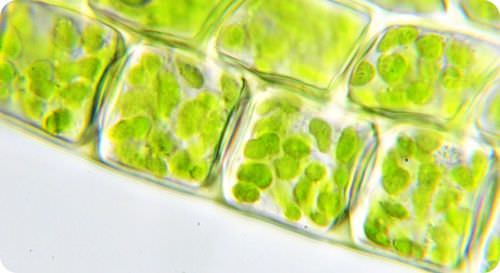2.8植物细胞结构
章节大纲
-
Do plants have cells like yours?
::植物有像你这样的细胞吗?Yes, your cells are actually very similar to a plant's cells. For example, they are both eukaryotic cells , both contain in a , and both make proteins in ribosomes . However, plant cells also differ in some crucial ways from your own cells.
::是的,您的细胞实际上与植物的细胞非常相似。例如,它们都是乳房细胞,两者都包含在一个细胞中,而且两者在血清中产生蛋白质。然而,植物细胞在某些关键方面也与自己的细胞不同。Plant Cells
::工厂电池Even though plants and animals are both eukaryotes , plant cells differ in some ways from animal cells ( Figure ). Plant cells have a large central vacuole , are surrounded by a cell wall , and have chloroplasts , which are the of . Photosynthesis converts the sun's solar energy into chemical energy . This chemical energy, which is the carbohydrate glucose , serves as "food" for the plant.
::植物细胞与动物细胞有些不同(图)。植物细胞有一个大中央真空,被一个细胞墙包围,并有氯板,它们是:光合作用将太阳的太阳能转化为化学能量。这种化学能量,即碳水化合物甘蔗糖,作为植物的“食物 ” 。A plant cell has several features that make it different from an animal cell, including a cell wall, huge vacuoles, and chloroplasts, which photosynthesize. Vacuoles
::空 空 空 空 人First, plant cells have a large central vacuole that holds a mixture of water, nutrients , and wastes. A plant cell's vacuole can make up 90% of the cell’s volume. The large central vacuole essentially stores water. In animal cells, vacuoles are much smaller.
::首先,植物细胞有一个庞大的中央真空,含有水、养分和废物的混合体。 植物细胞的真空可以占细胞容量的90%。 大型中央真空基本上储存着水。 在动物细胞中,真空要小得多。Cell Wall
::细胞墙壁Second, plant cells have a cell wall , while animal cells do not ( Figure ). The cell wall surrounds the plasma membrane but does not keep substances from entering or leaving the cell. A cell wall gives the plant cell strength and protection.
::第二,植物细胞有一个细胞墙,而动物细胞没有(图......) 细胞墙环绕等离子膜,但不阻止物质进入或离开细胞,细胞墙提供植物细胞的力量和保护。In this photo of plant cells taken with a light microscope, you can see green chloroplasts, as well as a cell wall around each cell. Plastids
::弹性体A third difference between plant and animal cells is that plants have several kinds of organelles called plastids . And there are several different kinds of plastids in plant cells. For example, Chloroplasts are needed for photosynthesis, leucoplasts can store starch or oil, and brightly colored chromoplasts give some flowers and fruits their yellow, orange, or red color. It is the presence of chloroplasts and the ability to photosynthesize, that is one of the defining features of a plant. No animal or can photosynthesize, and only some protists are able to. The photosynthetic protists are the plant-like protists, represented mainly by the unicellular .
::植物和动物细胞之间的第三个区别是植物有几种叫做粘合物的有机物。植物细胞中也有几种不同的粘合物。例如,光合作用需要氯甲醚,乳胶可以储存淀粉或油,而光彩色的染色体可以提供一些花朵和水果,它们的黄色、橙色或红色颜色。是叶片的存在和光合体的能力,这是植物的特征之一。没有动物或能够光合体,只有一些蛋白质可以使用。光合剂蛋白剂是植物相似的先质,主要代表的是非晶体。Summary
::摘要- Plant and animal cells differ in that plants have a large central vacuole, while animals have smaller vacuoles.
::植物和动物细胞各有不同,因为植物有一个较大的中央真空体,而动物的真空体较小。
- Plant cells also have cell walls and plastids, while animal cells do not.
::植物细胞还有细胞壁和粘合物,而动物细胞则没有。
Review
::回顾- What are three structures that are found in plant cells but not in animal cells?
::在植物细胞中发现的三种结构是什么,但在动物细胞中却不是?
- What is the role of the chloroplast?
::叶板的作用是什么?
- What is the main role of the plant vacuole?
::植物真空的主要作用是什么?
- Plant and animal cells differ in that plants have a large central vacuole, while animals have smaller vacuoles.


